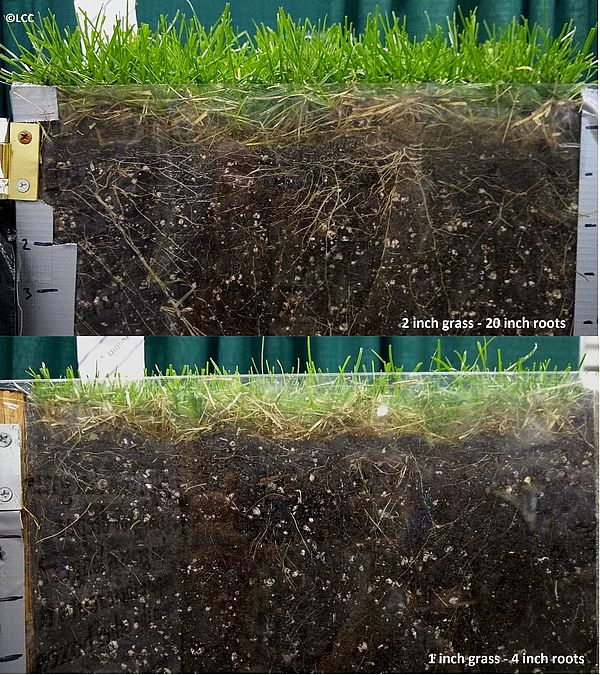Grass is the largest irrigated crop in the United States. It covers city parks, suburban lawns, and wide-open rural fields. Unfortunately, grass can be a major source of fertilizer runoff. While the best way to slow rainwater down and allow pollutants to settle out is to plant native grasses, shrubs, and trees instead of the traditional lawn, there are still things you can do to make your lawn green, healthy, and watershed friendly.
The first step is to raise the blade on your lawnmower to cut the grass at three inches. Long grass shades out the weeds, keeps moisture in the soil, and allows the roots to grow long. Longer roots further aid with rainwater absorption, creating channels for the water to seep into the soil, instead of flooding on the surface. They also hold soil in place against erosion and make the grass more drought-resistant, the longer roots able to reach deeper moisture in the soil. Long grass will stay green and soft throughout the withering summer heat, with minimal watering.
Next, keep your lawnmower blades sharp and follow the 1/3 rule. The 1/3 rule means that you only cut 1/3 of the grass blade off at a time – with three-inch-high grass you should allow it to grow between four and five inches long before cutting it back to three inches. By cutting less of the grass blade at a time, and making clean cuts with a sharp blade, the grass will experience less physiological stress. Instead of investing energy into restoring its’ leaves it will grow long, resilient roots, and be healthier overall.
Finally, reconsider using fertilizer. It’s now illegal (in both Vermont and New York) to use phosphorus fertilizer on an established lawn without a soil test for phosphorus deficiency. This is because most soil in the region is not, in fact, phosphorus deficient. Excess phosphorus applied in fertilizer instead runs into the lakes and streams, turning them green with an overabundance of weeds, algae, and toxic cyanobacteria blooms. If you do need to apply fertilizer avoid spreading it in the spring, when snowmelt and rains will wash it away, and instead put it down in the fall.
Many alternatives to fertilizer are also cheaper and easier to maintain. You can leave the grass clippings when you mow (a mulching blade will help break them up further), which will build up the organic content of your soil. You can also seed your lawn with clover, which naturally draws nitrogen from the air into the soil. Flowering clover has the added benefit of providing habitat for bees, although there are micro-flowered varieties if you are allergic to bee stings. Clover also stays green in dry conditions, shades out broad-leafed weeds, and flourishes in difficult patches – like deep shade or poorly drained soil.
